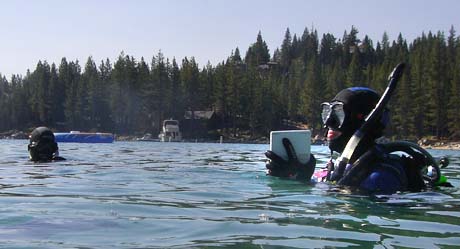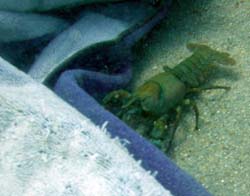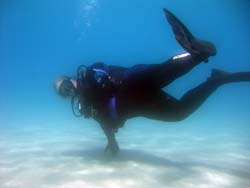« Diving at altitude revisited | Main | Dogs, tanks, suits and Nitrox »
July 24, 2008
Altitude diving class at Meeks Bay, Lake Tahoe
Almost two years ago I wrote how I got certified as an altitude diver at Lake Tahoe. I thought I had been, I really did. But it turned out that I never got my card and my old instructor vanished. So it seemed like a good idea to do the whole thing over again, and I signed up for the PADI altitude diver class with Fisheye Scuba in Folsom.
There really is no separate altitude class in the PADI system. Altitude is part of "Adventures in Diving" and the concepts and things to know are described in one big instruction manual. I bought the 375-page tome, studied, answered the quiz questions and did the knowledge review. I also attended the altitude portion of the class at Fisheye Scuba which took about an hour.
Instructor Kate Fuquay, who is also part-owner of Fisheye Scuba, wanted students to go up to Lake Tahoe the night before the class so our bodies could properly acclimate to the much higher altitude. A bit of research and calling around yielded a reasonably priced motel room, a rare commodity at Tahoe in just about any season. The motel did not have air conditioning and the room was baking hot despite open windows and night time temperatures dropping into the mid-40s. No big deal as thanks to a big fan I managed to sleep anyway.
Meeks Bay is on the other side of the lake and so it was a bit of a drive to get to the camping and resort area by 8AM. The Fisheye crew was already there and so was an assortment of students taking various classes. Meeks Bay actually has two beaches, a small one north of a marina entrance and a larger one south of it. Both have adequate parking close to the sandy beach and both have rest rooms. The larger resort area beach we used also has a nice store for campers and beachgoers, so that's a plus for when you want a drink, snack or a souvenir (I got a handy nautical map of the lake and surrounding waterways).
My new 6-1/2mm ScubaPro wetsuit went on a lot easier than the recalcitrant 7mm Telos I'd become used to fighting with, but it still took me time to don my gear and make sure all was well. We did the buddy check, then gathered around instructor Kate who spent time going through the special considerations of altitude diving as well as the plans for the dives. One advantage of a group this big (there were probably 20 of us all in all) was that we had a couple of non-divers, and so I had someone to look after my 12-year-old son Morgan who'd come along for the experience. He'd brought his snorkeling gear and I was sure he'd have a great time, but he's still only 12 and I wanted an adult to keep an eye on him.

The water was a nice, refreshing 68 degrees Fahrenheit but I had put on my hood anyway, knowing that Lake Tahoe can get quite chilly during a dive. We swam out to one of the buoys so we could descend on its line to the bottom where we'd compare and record the depths shown on our depth gauges or dive computers. That was on the agenda to see if all were altitude-adjusted and whether readings differed or not. I had my Uwatec SmartZ computer on my left wrist and the Timex Helix on my right. At the bottom the SmartZ showed 42 feet and the Timex 41. Close enough.
Lake Tahoe is wonderfully clear and generally has great viz, but a group of mostly novice divers all gathered at the bottom can fix that in a hurry and so we'd soon kicked up enough sand and silt to make it advisable to move on.  The bottom at Meeks Bay is sandy and shallow until it slopes away into the abyss at a 45 degree angle. There isn't a whole lot to see and so we swam along the slope at 50 feet or so. Visibility remained marginal for Tahoe and so our initial convoy soon lost sight of each other and split into smaller groups of twos and fours. It's amazing how quickly you can lose sight of other divers underwater. There weren't any boulders here or schools of fish, and so I mostly concentrated on buoyancy, checking my gear and instruments, and watching the occasional crawdad do its thing. Later I noticed that the temperature had actually dropped all the way to 50 degrees at some point and I never even noticed.
The bottom at Meeks Bay is sandy and shallow until it slopes away into the abyss at a 45 degree angle. There isn't a whole lot to see and so we swam along the slope at 50 feet or so. Visibility remained marginal for Tahoe and so our initial convoy soon lost sight of each other and split into smaller groups of twos and fours. It's amazing how quickly you can lose sight of other divers underwater. There weren't any boulders here or schools of fish, and so I mostly concentrated on buoyancy, checking my gear and instruments, and watching the occasional crawdad do its thing. Later I noticed that the temperature had actually dropped all the way to 50 degrees at some point and I never even noticed.
Morgan greeted us on the surface, clearly having a good time. We parked the gear at the shore and debriefed. Our assignment for the second altitude dive was to do a full dive plan, adjusted for altitude, pressure groups and all. Here's what Carol and I came up with:
Our first dive had been to 50 feet at Tahoe altitude of 6,230 feet. The 50 feet translates to a theoretical depth of 65 feet at sea level, so we round up to 70 feet. Our first dive was 29 minutes, so after that first dive we were PADI "N" divers. We then had a surface interval of 2:20 hours, and that brought us down to "A" diver status.
Our dive plan for the second dive was to go to 50 feet again. That again translated to a theoretical depth of 65 feet at sea level. We rounded that up to 70 feet, and found that as "A" divers with a residual nitrogen time of five minutes, that left us with an adjusted bottom time of 35 minutes.
 That was that, and we conducted the dive in accordance with the plan. On the second dive I used my compass to navigate to the northern edge of the beach where the underwater scenery was more interesting. We saw some of the huge boulders that had fascinated me on prior dives at Meeks. We swam around and between them, all at non-intimidating depths of just 30 to 40 feet or so. It was a fairly long underwater swim back to the beach, and I used that to once again practice buoyancy at shallow depths where staying level is most difficult. Once you reach eight or ten feet or so, it's all too easy to pop up like a cork and you don't want for that to happen. Constantly correcting by adding air to the BC and then discharging it again is no good; you need to learn to achieve buoyancy by changing the average volume of air in your lungs. Carol barely ever needs her ScubaPro Ladyhawk BC's assistance to maintain buoyancy, and I am getting better at it myself.
That was that, and we conducted the dive in accordance with the plan. On the second dive I used my compass to navigate to the northern edge of the beach where the underwater scenery was more interesting. We saw some of the huge boulders that had fascinated me on prior dives at Meeks. We swam around and between them, all at non-intimidating depths of just 30 to 40 feet or so. It was a fairly long underwater swim back to the beach, and I used that to once again practice buoyancy at shallow depths where staying level is most difficult. Once you reach eight or ten feet or so, it's all too easy to pop up like a cork and you don't want for that to happen. Constantly correcting by adding air to the BC and then discharging it again is no good; you need to learn to achieve buoyancy by changing the average volume of air in your lungs. Carol barely ever needs her ScubaPro Ladyhawk BC's assistance to maintain buoyancy, and I am getting better at it myself.
We were done diving by two o'clock in the afternoon or so, then headed for lunch/dinner at Rosie's Cafe in Tahoe City. Rosie's alone would have been worth the trip with some of the best Key Lime pie ever, but we also needed to let the residual nitrogen escape from our systems before we tackled the 7,400 feet summit on our way back.
This wasn't the greatest diving ever, but it was fun and I finally have that altitude card in the bag. Not that the card matters. Diving matters, the preparation and anticipation, the people you meet, everything about it. I love it.
Posted by conradb212 at July 24, 2008 3:40 PM








